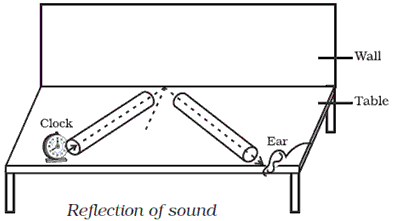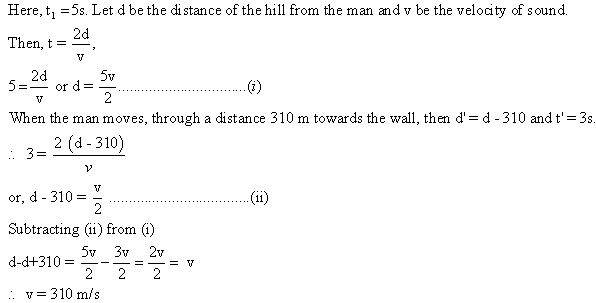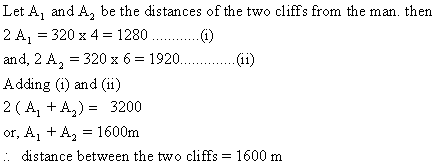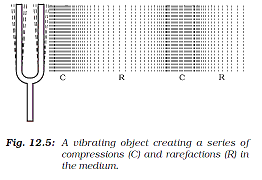Class 10 FRANK Solutions Physics Chapter 3.1 - Characteristics of Wave Motion and Echoes
Excel in your Physics exam with TopperLearning’s Frank Solutions for ICSE Class 10 Physics Chapter 3.1 Characteristics of Wave Motion and Echoes. Learn to distinguish between longitudinal waves and transverse waves. Find out whether a sound wave can pass through vacuum. Revise topics like infrasonics, rarefaction, supersonics, echo, SONAR etc. in this chapter.
Get complete ICSE Class 10 Physics e-learning resources to thoroughly prepare the topic of wave motion and echoes for your board exam. We have revision notes, self-assessment tests and more to support you in your Physics learning journey.
Characteristics of Wave Motion and Echoes Exercise 135
Solution 1
| Longitudinal waves | Transverse waves |
| 1. As it travels through a medium, the particles of the medium vibrate to and fro about their mean positions along the direction of propagation of wave. 2. As the wave propagates through the medium, it causes compressions and rarefactions. 3. In case of longitudinal waves, one wavelength contains one compression and one rarefaction. 4. They can travel through all media i.e. solids, liquids and gases. 5. As the longitudinal wave propagates through a medium, there is change in density of the medium. |
1. As it travels through a medium, the particles of the medium vibrate perpendicular to the direction of propagation of wave. 2. As the wave propagates through the medium, it produces crests and troughs. 3. In case of transverse waves, one wavelength contains one crest and one trough. 4. They can travel only through solids and on the surface of liquids. 5. As the transverse wave travels through a medium, there is no change in density of the medium. |
Solution 2
Solution 3
Solution 4
Solution 5
The velocity of a wave increases with the increase in temperature.
Solution 6

Characteristics of Wave Motion and Echoes Exercise 136
Solution 8
The high points of the waves are called crests or peaks and the low points of the waves are called troughs.
Solution 9
Solution 10
Solution 11
Solution 12
Solution 13
1. Wave motion can be produced only in a medium having elasticity and inertia.
2. When energy is given to any part of a medium, disturbance is produced in it by repeated periodic motion of the particles about their equilibrium positions.
3. During wave motion, no matter is transferred. It is only the energy that gets transferred.
4. The velocity of the wave relative to the medium depends only on the nature of the medium and not on the nature or motion of source of disturbance.
5. The velocity of the wave is different from the velocity with which the particles of the medium vibrate about their equilibrium positions.
6. Energy gets transferred from one particle of a medium to the next particle in a fixed interval of time.
7. The energy associated with the wave is the kinetic and potential energy of the matter.
Solution 14
Solution 15

Solution 16
Solution 17
It is also equal to the distance between any two points where the particles are passing through their respective mean positions in the same direction.
It is also the distance between two successive compressions or two successive rarefactions on a longitudinal wave.
The SI unit of wavelength is metre (m).
Solution 18
Solution 19
Solution 20
Solution 21
Solution 22
Solution 23
Solution 24
Solution 25
1. Jet aircrafts
2. Rockets
Solution 26
If the distance is less than 17 m, the reflected sound will reach the ears before the original sound dies out. In such a case, the original sound mixes up with the reflected sound. Due to repeated reflections at the reflecting surface, the sound gets prolonged. This effect is known as reverberation.
Solution 27
1. The minimum distance between the source of sound and its reflector should be 17 m.
2. Reflected sound should reach the person atleast 0.1 second after the original sound is heard.
Solution 28
Solution 29
Solution 30
1. Take two identical pipes, as shown in Fig. You can make the pipes using chart paper. The length of the pipes should be sufficiently long as shown.
2. Arrange them on a table near a wall.
3. Keep a clock near the open end of one of the pipes and try to hear the sound of the clock through the other pipe.
4. Adjust the position of the pipes so that you can best hear the sound of the clock.

Conclusion: Sound waves pass down the first tube and are reflected from the smooth surface of the wall. After reflection, they enter the second tube and are received by the ear at the other end. If you measure the angle of incidence and angle of reflection, you will notice that they are equal.
Solution 31
For example: A person stands at a known distance (d m) from a cliff and fires a pistol and simultaneously starts the stop watch. He stops the stop-watch as soon as he hears the echo. The distance traveled by sound during this time (t seconds) is twice the distance (2d m). The velocity (v) of sound is then calculated as under:
By repeating the experiment two or three times, the average velocity of sound can be calculated.
Solution 32
(ii) Dolphins detect their enemies and small fishes by emitting ultrasonic waves in all directions and then hearing their reflected sound i.e. echo. Dolphins can judge the nature of obstacles or of small fish by hearing the echo and catch their prey.
Solution 33
Solution 34
Solution 35

Solution 36
Solution 37
They produce and sent ultrasonic waves in all directions. When these waves are reflected back from the obstacles or prey, they hear the echo. From the time taken to hear the echo and from the nature of the sound received, bats, dolphins and fishermen are able to gauge the distance and type of surroundings.
Solution 38
Sonar is an instrument that makes use of ultrasonic waves for sound ranging. It is equipped to measure even short time intervals quite accurately.
Sonar works on the principle of echoes. A strong and short (ultrasonic) sound signal is sent towards the bottom of ocean. The echo of this signal is then detected by it. By noting the time after which the reflected sound (echo) reaches back, we can calculate the depth of the ocean by using the formula.
Depth of ocean = v x t/2, here v is the velocity of ultrasonic wave.
Solution 39
Solution 40

Solution 7
A longitudinal wave propagates by means of compressions and rarefactions.
When a vibrating object moves forward, it pushes and compresses the air in front of it creating a region of high pressure. This region is called a compression (C), as shown in Fig. This compression starts to move away from the vibrating object. When the vibrating object moves backwards, it creates a region of low pressure called rarefaction (R), as shown in Fig.
Compressions are the regions of high density where the particles of the medium come very close to each other and rarefactions are the regions of low density where the particles of the medium move away from each other.


